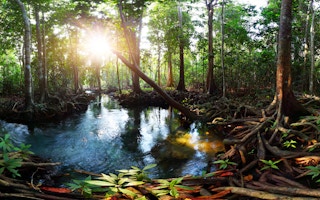With tropical peatlands and mangroves finally being recognized globally as vital in the fight against climate change, scientists are wasting no time in urging governments to develop national guidelines for measuring, verifying and reporting (MRV) of carbon stocks and emissions in these ecosystems.
A month before U.N. climate talks began in Warsaw, Poland, the Intergovernmental Panel on Climate Change (IPCC) executive committee adopted and accepted the so-called Wetlands Supplement in Batumi, Georgia. This decision paves the way for developing countries to integrate protection of tropical peatlands and mangroves into their climate change mitigation and adaptation strategies.
“Tropical peatlands and mangroves have exceptionally high carbon stocks, among the highest of any ecosystem on Earth,” said Daniel Murdiyarso, a principal scientist at the Center for International Forestry Research (CIFOR).
Recognition of the importance of these ecosystems is all the more crucial because they are rapidly disappearing due to agriculture and aquaculture developments, Murdiyarso said. When peat swamps and mangroves are drained, converted, and burned, large quantities of stored carbon are released into the atmosphere, contributing to climate change.
Converting these wetlands also undermines valuable ecosystem services, such as habitats for species, wood for lumber and protection against cyclones and tsunamis. These ecosystems are thus not only important for mitigation, but for adaptation as well.
Murdiyarso was one of several scientists who made presentations at U.N. Framework Convention on Climate Change (UNFCCC)/Subsidiary Body for Scientific and Technological Advice -organized workshop in Bonn, Germany, in October to discuss the state of knowledge on “ecosystems with high-Carbon reservoirs” and how to put the Wetlands Supplements into action.
One key area to be resolved relates to MRV, as well as identification of (land-use) activity and determination of emission factors — the average rate of emissions caused by a given activity, such as converting forest to crop land.
Emission factors are divided into three categories: Tier-1 measures default values that may be applied elsewhere and therefore carry large uncertainties, while Tier-2 is specifically derived from countries and Tier-3 use progressively sophisticated tools allowing process-based models to estimate emissions in a country.
At the downstream these issues were further debated at a November workshop in Jakarta, Indonesia, organized by the President’s Delivery Unit for Development Monitoring and Oversight (UKP4) and U.N. Office for REDD+ Coordination in Indonesia (UNORCID) — the country’s focal point for reducing emissions from deforestation and forest degradation.
Indonesia has a keen interest in addressing gaps in the measurement of emissions, particularly from peat. Forest conversion is largely responsible for Indonesia’s ranking as third highest emitter of CO2.
For Murdiyarso, the Jakarta workshop was an opportunity to raise awareness among UNFCCC climate change delegates about the value of tropical wetland ecosystems, which include tropical peatlands and mangroves. He also tried to connect the dots between the IPCC, UNFCCC and REDD+ processes, of which MRV is increasingly realized as an important step of the mechanism.
“My main message was that Indonesia can start its MRV by adopting IPCC methodologies to measure the release of GHGs from drained peatlands right now,” said Murdiyarso. Scientists must do further work to measure the depth or thickness of peat, as well as to generate more accurate estimates of peat volume, he added. Tools such as airborne- and ground-penetrating radar could help provide higher Tier to reduce uncertainties.
Emissions from burning peat are another area demanding further study. Murdiyarso moved further by taking part in a panel discussion in the Indonesia Pavilion on 14 November at the Warsaw climate talks organized by the National Climate Change Council.
“The adoption of the Wetlands Supplement was a long-awaited breakthrough to recognize the importance of tropical peatlands and mangroves for climate change,” Murdiyarso said. “We have to keep building on the momentum at the policy level, even as we develop more sophisticated and accurate ways to measure emissions factors.”










